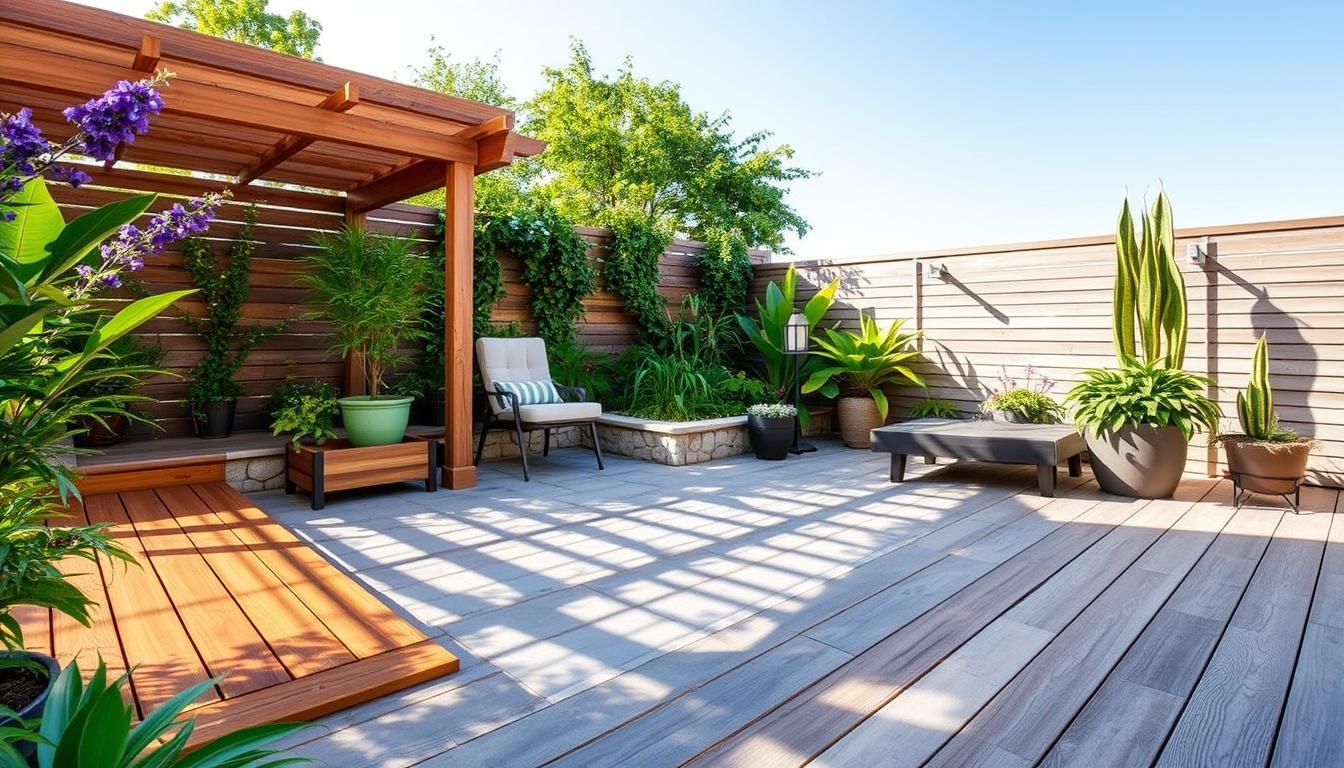Choosing the right outdoor flooring is key for durability, upkeep, and looks. The right flooring can transform your property, making it more welcoming and useful. This guide will cover various outdoor flooring options, their installation, and upkeep. We aim to give you a detailed guide to help you make a smart choice.
Outdoor flooring choices range from natural stone to composite materials, each with its own pros and cons. Knowing these differences is vital for picking the best flooring for your needs and taste. By considering weather resistance, safety, and upkeep, you can find flooring that meets your expectations and lasts long.
With the right flooring, you can create a stunning and practical outdoor area that fits your lifestyle and boosts your property’s value. Our aim is to offer a thorough installation guide. It will cover all aspects of outdoor flooring, from options to maintenance, to assist you in choosing the perfect flooring for your space.
Key Takeaways
- Choose outdoor flooring options that meet your specific needs and preferences
- Consider factors such as weather resistance, safety, and maintenance
- Outdoor flooring can enhance the overall look and feel of your property
- A comprehensive installation guide is essential for a successful outdoor flooring project
- Regular maintenance is crucial to extend the lifespan of your outdoor flooring
- Outdoor flooring options can affect your property’s value and aesthetic appeal
Understanding Outdoor Flooring and Its Importance
Many homeowners underestimate the role of outdoor flooring in enhancing their property’s look and value. It’s not just about functionality; it significantly impacts property value. A well-chosen and installed outdoor flooring can enhance a property’s curb appeal, attracting potential buyers.
The weather resistance of outdoor flooring is paramount. It faces various environmental challenges like rain, sun, and extreme temperatures, leading to damage. Thus, selecting materials that resist weather conditions is crucial. This ensures the flooring’s longevity and reduces maintenance costs.
Impact on Property Value
A high-quality outdoor flooring can significantly boost a property’s value. It makes the property more appealing to potential buyers, increasing its resale value. The material, design, and installation quality are key factors in this impact.
Weather Resistance Requirements
When selecting outdoor flooring, weather resistance is a critical factor. The material must withstand extreme temperatures, heavy rain, and intense sunlight. Popular options include concrete, brick, and stone.
Safety Considerations
Safety is essential in outdoor flooring. It should be slip-resistant, crucial in areas like near pools or outdoor kitchens. The flooring must also be durable, handling heavy foot traffic well.
Considering these factors helps homeowners select the right outdoor flooring. It enhances both the aesthetic and functionality of a property, whether it’s a patio, deck, or pool area.
| Outdoor Flooring Material | Weather Resistance | Safety Considerations |
|---|---|---|
| Concrete | High | Slip-resistant |
| Brick | High | Durable |
| Stone | High | Slip-resistant |
Popular Outdoor Flooring Materials
Choosing the right flooring for your outdoor space involves several options. Patio surfaces can be crafted from natural stone, wood, or composite materials. Each material has its own set of benefits and drawbacks, making the ideal choice dependent on your specific needs and preferences.
Popular choices for outdoor flooring include:
- Natural stone, such as granite or slate, which is durable and low maintenance
- Wood, which can add a warm and cozy touch to your outdoor space
- Composite materials, which are made from a combination of materials and are often more affordable than natural stone or wood
- Deck tiles, which are a great option for creating a unique and personalized outdoor space
When selecting flooring, durability and maintenance are key considerations. Flooring materials exposed to the elements can suffer damage and wear. It’s crucial to choose a material that can withstand the elements and requires minimal upkeep.
Aside from durability and maintenance, the aesthetic appeal of the flooring material is also vital. Patio surfaces and deck tiles offer a wide range of colors and styles. This ensures you can find a material that complements your outdoor decor.
| Flooring Material | Benefits | Drawbacks |
|---|---|---|
| Natural Stone | Durable, low maintenance | Expensive, heavy |
| Wood | Warm, cozy, affordable | Prone to rot, requires regular maintenance |
| Composite Materials | Affordable, durable, low maintenance | May not be as aesthetically pleasing as natural stone or wood |
Natural Stone Options for Outdoor Spaces
Natural stone is a top pick for outdoor flooring, prized for its durability and beauty. Materials like granite, slate, and limestone combine style with practicality. They are stunning and easy to care for, perfect for outdoor areas.
Natural stone stands up well to harsh weather. Granite, for instance, can handle extreme temperatures. Slate is known for its slip-resistance. Limestone, with its warm tones, is also durable. Here’s a quick look at each stone’s key traits:
| Material | Durability | Aesthetic Appeal | Maintenance Requirements |
|---|---|---|---|
| Granite | High | Polished, sleek | Low |
| Slate | High | Rustic, textured | Low |
| Limestone | Medium | Warm, earthy | Medium |
The right natural stone depends on your taste and outdoor space needs. Think about durability, looks, and upkeep. This way, you can pick the best natural stone for your space and enjoy it for many years.
Wooden Deck Solutions and Applications
Wooden decks are a timeless choice for outdoor flooring, cherished for their natural beauty and warmth. They offer a classic appeal that many homeowners find irresistible. The variety of wood types available means each deck can have its own distinct character and advantages.
Wooden decks enhance property value, create a cozy outdoor space, and add warmth. Yet, it’s crucial to understand the upkeep needed to keep them looking great. Regular care can significantly extend the deck’s life and prevent weather damage.
Choosing the right wood and proper installation techniques are key to a safe and lasting deck. Popular options include cedar, pine, and redwood. These woods vary in their resistance to rot and insects, and can be treated to boost their look.
In summary, a wooden deck can beautifully transform any outdoor area, offering a space for both relaxation and entertainment. With the right care, it can endure for decades, proving to be a valuable addition to any home.
Composite and Synthetic Outdoor Flooring
For those looking for low-maintenance options, composite and synthetic materials are excellent choices. These include composite flooring, PVC decking, and rubber flooring. They are known for their durability and resistance to rot and insect damage. These materials are also eco-friendly and come in a variety of styles.
Some benefits of composite and synthetic outdoor flooring include:
- Low maintenance requirements
- Resistance to rot and insect damage
- Environmentally friendly options
- A range of aesthetic choices
When it comes to specific types of composite and synthetic flooring, PVC decking stands out for its durability and ease of installation. Rubber flooring is another excellent option, providing a soft and slip-resistant surface. Composite flooring is versatile, available in various colors and styles to enhance any outdoor space.
In terms of cost, composite and synthetic outdoor flooring may be pricier than traditional materials. Yet, they offer long-term savings due to their low maintenance needs and durability. With proper installation and care, these materials can endure for many years. This makes them a valuable investment for homeowners.
| Material | Cost | Maintenance Requirements |
|---|---|---|
| Composite Flooring | Medium to High | Low |
| PVC Decking | Medium | Low |
| Rubber Flooring | Low to Medium | Low |
Professional Installation Guidelines
Choosing a professional for outdoor flooring installation is crucial. A skilled installation ensures the job is done right and safely. Professionals start by thoroughly assessing the site and preparing the ground for the new flooring.
Experienced installers use their expertise and the right tools to complete the job efficiently. Once the flooring is in place, they offer guidance on how to care for it. This ensures your outdoor space remains beautiful for years.
Hiring a professional for your outdoor flooring installation offers several benefits:
- Expertise and experience
- Access to high-quality materials
- Efficient and safe installation process
- Guidance on maintenance and care
A professional installation comes with a detailed guide. This outlines the installation steps and what to expect. It helps you feel more confident and in control during the process.
Opting for a professional installation guarantees your flooring is installed correctly and safely. You’ll get the best results, whether you need a simple or complex design. A professional guide helps you achieve your desired outcome.
DIY Installation Tips and Techniques
For those who enjoy DIY projects, installing outdoor flooring can be a cost-effective option. It requires the right tools and knowledge for a successful installation. Careful planning and attention to detail are key to avoid common mistakes.
Before starting, gather all necessary tools. This includes a tape measure, level, and safety gear like gloves and goggles. A well-prepared DIY installer will also understand the step-by-step process, from preparing the subfloor to laying the final flooring piece.
Common Tools Needed
- Tape measure
- Level
- Safety gear (gloves, goggles)
- Power saw or cutter
- Drill and bits
By following a step-by-step guide and avoiding common mistakes, DIY installers can achieve professional-looking results. Common mistakes include uneven flooring, incorrect spacing, and inadequate sealing. With the right tools and patience, DIY installation can be rewarding and successful.
Avoiding Common Mistakes
To ensure a successful DIY installation, it’s crucial to be aware of common mistakes. Double-check measurements, use the correct materials, and follow the manufacturer’s instructions. By planning and preparing, DIY installers can create a beautiful and functional outdoor space that will last for years.
| Mistake | Prevention |
|---|---|
| Uneven flooring | Use a level to ensure even surface |
| Incorrect spacing | Follow manufacturer’s spacing guidelines |
| Inadequate sealing | Apply recommended sealant to protect flooring |
Weather Protection and Sealing Methods
Keeping your outdoor flooring safe from the elements is key to its longevity. Weather protection is vital to ward off damage from rain, sun, and extreme temperatures. Sealing methods effectively create a barrier between the flooring and the environment.
Several sealing methods are available, such as topical, penetrating, and composite sealers. Topical sealers are applied to the flooring’s surface. Penetrating sealers, on the other hand, soak into the material for internal protection. Composite sealers offer a blend of both benefits.
When selecting a sealing method, consider your flooring type and local climate. For instance, high rainfall areas benefit from sealers that offer enhanced weather protection. Popular choices include:
- Silicone-based sealers
- Acrylic-based sealers
- Polyurethane-based sealers
Applying the correct sealing methods and ensuring adequate weather protection can significantly extend your outdoor flooring’s lifespan. It also helps maintain its appearance.
Essential Maintenance Practices
Regular maintenance is crucial for extending your outdoor flooring’s lifespan. To maintain your outdoor spaces’ appearance, adopting good maintenance practices is essential. This includes daily care, seasonal maintenance, and repair procedures. By following these tips, your outdoor flooring will remain safe, durable, and visually appealing.
Daily care is the foundation of good maintenance. It involves sweeping or blowing leaves and debris off the floor and cleaning up spills immediately. Seasonal maintenance is also vital, as it prevents damage from extreme weather. This may include sealing the floor, applying a protective coating, or repairing damaged areas.
Daily Care Tips
- Sweep or blow leaves and debris off the floor regularly
- Clean up spills immediately to prevent staining
- Check the floor for damage and make repairs as needed
Seasonal Maintenance
Seasonal maintenance tasks include sealing the floor, applying a protective coating, or repairing damaged areas. These actions help prevent damage from extreme weather, such as heavy rainfall or intense sunlight. By focusing on seasonal maintenance, you can extend your outdoor flooring’s life and maintain its appearance.
Repair Procedures
Even with good maintenance, repairs may be necessary from time to time. This could involve replacing damaged boards, resealing the floor, or other repairs. By promptly addressing repairs, you can prevent further damage and ensure your outdoor flooring remains safe and functional.
| Maintenance Task | Frequency | Importance |
|---|---|---|
| Daily Care | Daily | High |
| Seasonal Maintenance | Seasonally | Medium |
| Repair Procedures | As Needed | High |
Cost Considerations and Budgeting
When selecting outdoor flooring, cost considerations are crucial. Understanding the costs, including material pricing and installation costs, aids in making a budget-friendly choice. This ensures homeowners can find an option that aligns with their financial plans.
The material pricing varies widely among outdoor flooring types. Costs differ based on material type and quality. For instance, natural stone like granite and slate is pricier than wooden decks.
Another critical aspect is installation costs. These can fluctuate based on project complexity, area size, and installer labor rates. It’s vital to request quotes from several installers to compare prices and secure the best deal.
Here is a breakdown of the estimated costs:
| Material | Material Pricing | Installation Costs |
|---|---|---|
| Natural Stone | $10-$20 per square foot | $5-$10 per square foot |
| Wooden Deck | $5-$10 per square foot | $3-$5 per square foot |
| Composite Materials | $7-$15 per square foot | $4-$8 per square foot |
By examining these cost considerations and evaluating each option’s pros and cons, homeowners can make an informed choice. This ensures their selection meets both their needs and budget.
Conclusion: Making the Right Outdoor Flooring Choice
Throughout this guide, you’ve discovered the importance of choosing the right outdoor flooring. It’s not just about looks; durability and maintenance are key. Whether you prefer the natural beauty of stone or the classic charm of wooden decks, the right choice can make your outdoor area stand out. It also boosts your property’s value.
Understanding the pros and cons of each material is crucial. Knowing how to install and maintain your flooring is essential. This knowledge helps you make a choice that fits your budget, style, and needs. Quality outdoor flooring is an investment that pays off over time, enhancing both beauty and function.
Explore the many flooring options available. If needed, seek advice from experts. Trust your instincts to pick the best for your outdoor space. With the right choice, your backyard, patio, or deck can become a stylish oasis. It will seamlessly connect your indoor and outdoor areas.


